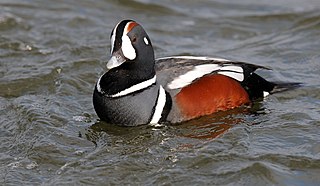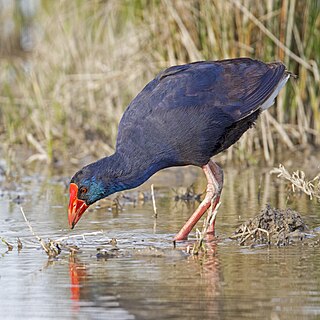
The megapodes, also known as incubator birds or mound-builders, are stocky, medium-large, chicken-like birds with small heads and large feet in the family Megapodiidae. Their name literally means "large foot" and is a reference to the heavy legs and feet typical of these terrestrial birds. All are browsers, and all except the malleefowl occupy wooded habitats. Most are brown or black in color. Megapodes are superprecocial, hatching from their eggs in the most mature condition of any bird. They hatch with open eyes, bodily coordination and strength, full wing feathers, and downy body feathers, and are able to run, pursue prey and, in some species, fly on the day they hatch.

The four species of avocets are a genus, Recurvirostra, of waders in the same avian family as the stilts. The genus name comes from Latin recurvus, 'curved backwards' and rostrum, 'bill'. The common name is thought to derive from the Italian (Ferrarese) word avosetta. Francis Willughby in 1678 noted it as the "Avosetta of the Italians".

The harlequin duck is a small sea duck. It takes its name from Harlequin, a colourfully dressed character in Commedia dell'arte. The species name comes from the Latin word "histrio", meaning "actor". In North America it is also known as lords and ladies. Other names include painted duck, totem pole duck, rock duck, glacier duck, mountain duck, white-eyed diver, squeaker and blue streak.

The western swamphen is a species of swamphen in the rail family Rallidae, one of the six species of purple swamphen. From the French name talève sultane, it is also known as the sultana bird. This chicken-sized bird, with its large feet, bright plumage and red bill and frontal shield is easily recognisable in its native range. It used to be considered the nominate subspecies of the purple swamphen, but is now recognised as a separate species. The western swamphen is found in wetlands in Spain, Portugal, southeastern France, Italy and northwestern Africa.

Allen's gallinule, formerly known as the lesser gallinule, is a small waterbird of the family Rallidae.

The purple gallinule is a swamphen in the genus Porphyrio. It is in the order Gruiformes, meaning "crane-like", an order which also contains cranes, rails, and crakes. The purple gallinule is a rail species, placing it into the family Rallidae. It is also known locally as the yellow-legged gallinule. The specific name martinica denotes "of Martinique".

The white swamphen, also known as the Lord Howe swamphen, Lord Howe gallinule or white gallinule, is an extinct species of rail which lived on Lord Howe Island, east of Australia. It was first encountered when the crews of British ships visited the island between 1788 and 1790, and all contemporary accounts and illustrations were produced during this time. Today, two skins exist: the holotype in the Natural History Museum of Vienna, and another in Liverpool's World Museum. Although historical confusion has existed about the provenance of the specimens and the classification and anatomy of the bird, it is now thought to have been a distinct species endemic to Lord Howe Island and most similar to the Australasian swamphen. Subfossil bones have also been discovered since.

The black-billed amazon is a parrot endemic to Jamaica. Sometimes called the black-billed parrot, this amazon parrot is mostly green with small patches of red on the wing and sometimes flecked on the head. Its bill makes it easy to separate from most other amazons, including the yellow-billed amazon, which also lives in Jamaica. It is the smallest Amazona parrot at 25 cm (10 in).

The Australian brushturkey, Australian brush-turkey, or gweela, also frequently called the scrub turkey or bush turkey, is a common, widespread species of mound-building bird from the family Megapodiidae found in eastern Australia from Far North Queensland to Eurobodalla on the South Coast of New South Wales. The Australian brushturkey has also been introduced to Kangaroo Island in South Australia. It is the largest extant representative of the family Megapodiidae, and is one of three species to inhabit Australia.

Porphyrio is the swamphen or swamp hen bird genus in the rail family. It includes some smaller species of gallinules which are sometimes separated as genus Porphyrula or united with the gallinules proper in Gallinula. The Porphyrio gallinules are distributed in the warmer regions of the world. The group probably originated in Africa in the Middle Miocene, before spreading across the world in waves from the Late Miocene to Pleistocene.

The Réunion swamphen, also known as the Réunion gallinule or oiseau bleu, is a hypothetical extinct species of rail that was endemic to the Mascarene island of Réunion. While only known from 17th- and 18th-century accounts by visitors to the island, it was scientifically named in 1848, based on the 1674 account by Sieur Dubois. A considerable literature was subsequently devoted to its possible affinities, with current researchers agreeing it was derived from the swamphen genus Porphyrio. It has been considered mysterious and enigmatic due to the lack of any physical evidence of its existence.

The red-billed brushturkey also known as red-billed talegalla or Cuvier's brushturkey, is a large, up to 57 cm long, black megapode with bare yellow facial skin, a reddish orange bill, yellow iris, and orange feet. The head is covered with bristle-like black feathers. The sexes are similar.

The black-billed brushturkey, yellow-legged brushturkey or black-billed talegalla is a species of bird in the family Megapodiidae. It is found in the Aru Islands and New Guinea. Its natural habitat is subtropical or tropical moist lowland forest.

The collared brushturkey, brown-collared brushturkey, or red-legged brushturkey is a species of bird in the family Megapodiidae. It is found in the northern part of New Guinea. Its natural habitats are subtropical or tropical moist lowland forest and subtropical or tropical moist montane forest.

The hook-billed kingfisher is a species of kingfisher in the subfamily Halcyoninae that is resident in the lowland forested areas of New Guinea and some of the nearby islands. It is the only member of the genus Melidora.

The Society kingfisher or Tahiti kingfisher is a species of bird in the family Alcedinidae. It is endemic to the Society Islands of French Polynesia. Its natural habitats are subtropical or tropical moist lowland forest and subtropical or tropical moist montane forest.

The Australasian swamphen is a species of swamphen (Porphyrio) occurring in eastern Indonesia, Papua New Guinea, Australia and New Zealand. In New Zealand, it is known as the pūkeko. The species used to be considered a subspecies of the purple swamphen.

Brushturkey, brush-turkey or brush turkey generally refer to birds in three genera in the megapode family, and sometimes to other species such as the Australian bustard:

The grey-headed swamphen is a species of swamphen occurring from the Middle East and the Indian subcontinent to southern China and northern Thailand. It used to be considered a subspecies of the purple swamphen, but was elevated to full species status in 2015; today the purple swamphen is considered a superspecies and each of its six subspecies groups are designated full species.

Philippine swamphen is a species of swamphen occurring in the Philippines and in the Talaud Islands, Indonesia. In the Philippines, it is found on Luzon, Mindanao, and other larger islands. Its habitat is dense reedbeds in swamps and wetlands, and fringing vegetation by lakes, ponds and rivers.
























